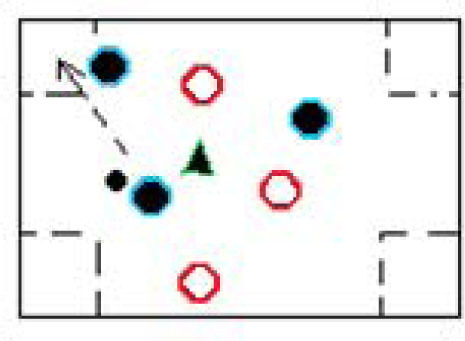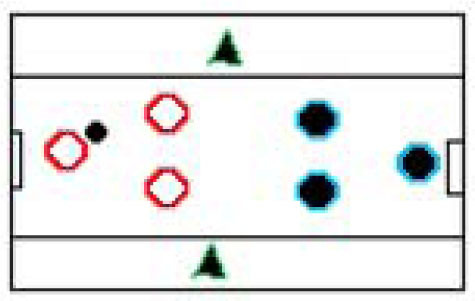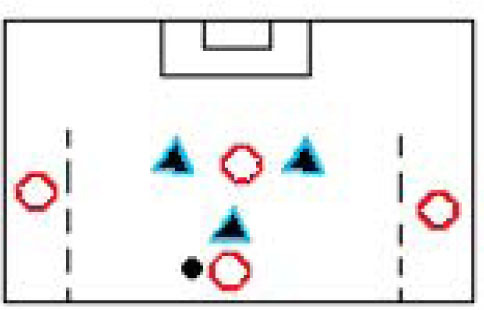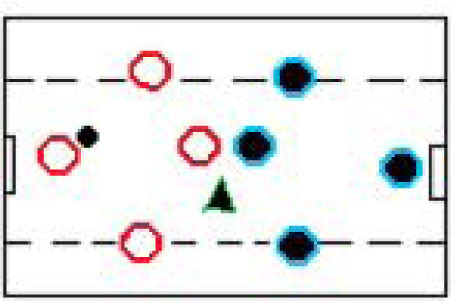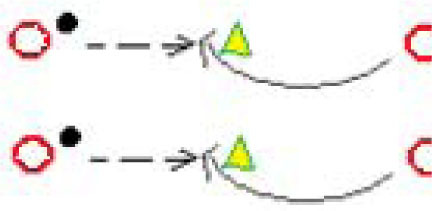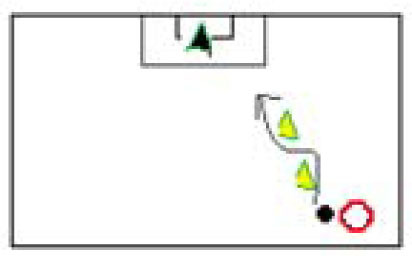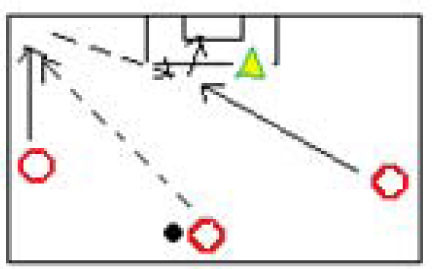Abstract
The aim of this study was to analyze the effect of a teaching program, based on Non-Linear Pedagogy, on decision-making and performance in youth soccer players as a function of the type of play action. Our participants were 19 players from the U12 age category. The teaching program, which was based on the application of modified games characterized by a numerical superiority in attack, was used for 14 training sessions. This program was conducted in two phases (preparation-for-intervention and intervention). Decision-making and execution for pass and dribbling actions were evaluated through the Game Performance Evaluation Tool. The results showed significant differences in favour of the experimental group in decision-making (p < .000) and the execution of passes (p = .003) after the intervention. However, such differences were not found for dribbling (decision-making, p = .402 and execution, p = .143). These findings demonstrate the effectiveness of this type of program for teaching actions with a high tactical component, such as the pass, and a different approach must be considered in actions with a high technical component, such as dribbling. It is necessary to continue developing studies in this line to clarify these issues.
Key words: non-linear pedagogy, modified games, training categories, youth soccer
Introduction
Among the variables that determine the achievement of motor skills in sport, a number are related to tactical knowledge and decision-making (McPherson, 2008). These variables are particularly relevant for sports defined by shared space and simultaneous participation (i.e., invasion sports such as soccer) where there is a constant uncertainty about an opponent’s actions (García-González et al., 2009).
Traditionally the predominant teaching models in sports training have been those focused on technique (Moy et al., 2015). These teaching models prioritize the acquisition of technical skills in an isolated form (i.e., away from the context of real game needs) as a step preceding the introduction of tactical aspects and the rules of the game (Mitchell et al., 2006). In other words, these models encourage decontextualized teaching. Such models are therefore characterized by the development of passive players who simply replicate or repeat what the coach transmits. This approach ultimately makes it difficult for players to develop their cognitive skills, such as decisionmaking (Allison and Thorpe, 1997).
As a result of the limitations associated with these traditional models (Renshaw et al., 2010), new teaching-learning perspectives such as Nonlinear Pedagogy (NLP) have emerged. These are characterized by integrated teaching of technical-tactical skills (Chow et al., 2006). NLP is characterized by its emphasis on the interaction between athletes and the environment through the use of modified games (Chow et al., 2006; Renshaw et al., 2010, 2015). Here the coach has a more passive role compared with traditional models, giving players space to inquire and make decisions by themselves (Renshaw et al., 2015). In this perspective, the learner is implicitly challenged within practice to understand “what to do” and “how to do it” in relation to specific motor skills. For example, in soccer learning to dribble a ball around a set of cones does little to help learners adapt their movement patterns to an active, moving opponent, or the actions of their team mates. Instead, skill execution should occur within more dynamic scenarios that represent task ‘simplifications’ of actual game skills (i.e., dribbling around initially passive defenders who become increasingly more active as learning increases, and passing to team-mates when opportunities arise) (Chow et al., 2009).
The teaching-learning process under the NLP perspective is focused on the manipulation of relevant conditions (player, task and environment) in order to amplify the sources of information that can be used to guide students toward their objectives (Passos et al., 2008), and ultimately promote a search for solutions for themselves. Specifically, in soccer, which is a sport of open motor skills, the game conditions (game principles, number of players, level of opposition, space, goal, time and rules of the game) become even more relevant because the modification of some of these conditions will allow players to adapt their actions to a changing environment, as it is common in real game scenarios (Passos et al., 2008). Also, the representativeness of these games in the context of training will allow a greater transfer of skills to competition matches (Renshaw et al., 2009). Therefore, as soccer can be understood as a dynamic system in which athletes must select responses, the analysis must not only be of technical variables, but also of tactical variables such as decision-making (Davids et al., 2013).
Regarding the manipulation of task constraints, the level of opposition has recently been recognized as a core issue in a number of studies (Sampaio et al., 2014; Travassos et al., 2014). Those studies have demonstrated that when the level of opposition was lower, the distance between the defenders and the trajectory of the ball was greater. Passing actions were also made in a more successful way. In a study carried out with youth players (Práxedes et al., 2016b), which analyzed the effect of modified games on numerical superiority and numerical equality in attack, the time the player had to decide was shown to be greater when the level of opposition was lower. This increased time that allowed athletes to gain better acquisition of technical-tactical skills. However, unlike with previous studies with older players (average age of 20 years), in that study no significant differences were observed in passing. A difference was however observed in dribbling. In this sense, it seems that for young teams the effects caused by the manipulation of the level of opposition may be different according to the technical-tactical action studied.
There are also studies that have found differences between the actions of passing and dribbling after the application of different teaching models. These emphasize the effectiveness of the technical teaching model for dribbling and the tactical model for passing (Psotta and Martin, 2011). A recent study aimed to analyze differences in decision making and action execution after a program of intervention based on the Teaching Games for Understanding (TGFU) model (Práxedes et al., 2017). The study revealed differences between the technical-tactical actions studied, with the greatest effect for the pass action. Although there is no conclusive research evidence to explain this result, there is still predominance in the scientific literature of descriptive studies with semi-professional players (Gonçalves et al., 2016; Sampaio et al., 2014; Travassos et al., 2014) over quasi-experimental studies involving young soccer players (Práxedes et al., 2017). There are also no investigations thus far that have attempted to analyze the effect of teaching programs focused on the manipulation of conditions, such as the level of opposition, on different technical-tactical actions, thus the novelty of our study.
Finally, it is necessary to point out that modified games, through the manipulation of the relevant constraints of the task, offer variability to practice (Chow et al., 2009), a key aspect to take into account in the development of young players. Also, in regard to the level of opposition, Mitchell et al. (2006) pointed out that the manipulation of these constraints (i.e. modified games) allowed coaches to grade the tactical complexity of the task, adjusting it to the needs of athletes and creating an appropriate level of challenge. It is therefore of particular relevance to implement teaching programs based on modified games and to analyze their effect on variables that determine sports skills, such as decision-making and execution. Therefore the aim of this study was to analyze the effect of a teaching program based on Nonlinear Pedagogy on decision-making and action execution in young players in relation to different game actions.
Methods
Participants
Our sample comprised 19 male soccer players belonging to two U12 teams from the same Spanish club (natural groups not modified for research). These teams had been formed by this club prior to the study. The experimental group was composed of 10 players from one team (age, M = 10.55 and SD = 0.51; experience, M = 3.9, SD = 1.19), and the control group of 9 players from the second team (age, M = 11.77 and SD = 0.66; experience, M = 4.88, SD = 1.05).
Both teams were of similar sports level. To guarantee the homogeneity of the groups, and as a preliminary step toward the application of the teaching program with the experimental group, an analysis of homogeneity of variance was performed using the Levene’s test. This proved that the two groups were equivalent in terms of variables and actions. In addition, both groups were in the same league (the local league) and facing the same teams, and therefore the level of opposition was the same.
The research was developed under the recommendations of the Declaration of Helsinki. The participants and their parents were informed about the study details. Then the parents signed an informed consent form as studied athletes were under 18. The research project was approved by the Ethics Research Committee of the University of Extremadura (Spain).
Intervention
The independent variable was the program of sports education based on the Nonlinear Pedagogy, which was conducted over 14 sessions. Given the characteristics of the participants (players in training stages), the teaching program was based on the development of tasks through the use of modified games in numerical superiority. Such proceeding provided a greater time to make decisions. The objectives for the sessions of the experimental group, in which an integration of technical and tactical aspects was always sought, are displayed in Table 1.
Table 1.
Scheme of work used in the study in each intervention phase.
| Session number | Session objectives | |
|---|---|---|
|
| ||
| Attack | Defense | |
| 1 | Space (width and depth in attack) | Prevent lines of passes and anticipation |
| 2 | Penetration (attack the goal) | Covering |
| 3 | Mobility to interchange of positions | Pressing |
| 4 | Dealing with crosses | Closing down |
| 5 | Mobility to create lines of pass | Balance (cut lines of passes) |
| 6 | Creation and occupation free spaces | Marking |
| 7 | Penetration (creation of an advantage in number) | Occupy spaces |
| 8 | Space (width and depth in attack) II | Prevent lines of passes and anticipation II |
| 9 | Penetration (attack the goal) II | Covering II |
| 10 | Mobility to interchange of positions II | Pressing II |
| 11 | Dealing with crosses II | Closing down II |
| 12 | Mobility to create lines of pass II | Balance (cut lines of passes) II |
| 13 | Creation and occupation free spaces II | Marking II |
| 14 | Penetration (creation of an advantage in number) II | Occupy spaces II |
To further illustrate the contents of the sessions, Table 2 presents an example, specifically session 1 for the experimental group. The objectives of all exercises were aimed at achieving tactical, offensive, space (width and depth in attack), and defensive (prevent lines of passes and anticipation) objectives.
Table 2.
Sample session of the experimental group teaching program.
| OBJECTIVE | EXPLANATION | GRAPHIC |
|---|---|---|
| 1st tactical principle: possession of the ball | 5 vs. 5 + 1 wild card in ¼ of the F8 field. Offensive objective: keep possession of the ball (reward with 1 point) and receive in turn in one of the squares of the corners (reward with 2 points). Defensive objective: Anticipate and steal the ball (awarded 1 point). |
|
|
| ||
| 2nd tactical principle: progression towards the goal | Offensive objective: before scoring a goal in one of the two goals (rewarded with 1 point), players must play with the wild cards (lateral players in this game). Defensive objective: Anticipate and steal the ball (awarded 1 point). |
|
|
| ||
| 2nd and 3rd tactical principle: progression and launch with the lowest level of opposition | 4 vs. 3 in ¼ of the F8 field. Offensive objective: before shooting, progress towards this giving an essential pass to a teammate who is located in one of the bands. Defensive objective: Anticipate and steal the ball (rewarded with a change of roles) |
|
|
| ||
| Modified game similar to the real context. | 4 vs. 4 + the 2 goalkeepers + 1 wild card in the middle of the F8 field. Offensive objective: to score goal in the opposite goal with the following premise: whenever a pass is given to a side, it must be located in the area that delimits the dashed line. Defensive objective: Anticipate and steal the ball (awarded 1 point) |
|
Table 3.
Sample session of the control group teaching program.
| OBJECTIVE | EXPLANATION | GRAPHIC |
|---|---|---|
| Pass Control and Control Technology | 1 + 1. Players are placed in pairs facing each other. The task is to perform a control correctly before passing to the partner. Once this objective has been met, the player receiving the ball does an oriented control with one foot (e.g. left), and makes a pass to the partner with the other foot (e.g. right). |
|
|
| ||
| Head strikes in advance | 1 + 1. 3 cones are placed in a line. In pairs, players are each placed by a cone, leaving the middle cone free. The goal is to pass the ball and for the partner to intercept the ball before it reaches the middle cone. |
|
|
| ||
| Zig-zag dribbling with an attempt to the goal | 1 vs. 0. The objective is to conduct a zig-zag line through the cones and shoot at the goal without opposition. |
|
|
| ||
| Lateral depth and antidpation to the defense in shooting at the goal. | 3 vs. 0. Players are placed as in the picture. The player with the ball makes a pass to the lateral player who is unmarked. After that, he has to give a pass to another teammate that has to anticipate the cone which represents a defence player. |
|
|
| ||
| Real game | 6 vs. 6 with goalkeepers and without delimiting zones. A point is scored to the team that manages to score in the opposition’s goal. There are no rules other than the usual rules of soccer. |
|
In each training session for the experimental group, 4 motor tasks, each lasting a total of 15 min, were carried out. These were designed to be similar to the real context of play and each referred to a tactical principle of play (to maintain the possession of the ball, to progress towards the goal, and to shoot at goal with the lowest level of opposition). In all tasks the level of opposition was manipulated, equality vs. numerical inequality of the participating teams, and considered to reflect the level of difficulty that the task presented (Sampaio et al., 2014). In all tasks the size of the field was reduced to between ¼ (15 x 10 m) and ½ of the soccer field (30 x 20m) according to the number of players, which was also reduced to 3-4 players per team in order to increase participation. The modifications of the rules of the game were made explicit. For example, to encourage clearances and passes in depth, the objective of the task was to receive while moving in a specific area, instead of shooting at the goal. In terms of the rules it should be noted that at no time were the number of touches limited. The ball that was used was always standard size. In parallel, the control group developed their training following the direct instruction model, prioritizing the technical component of execution without manipulating the conditions of the task.
It must be emphasized that both teams were from the same soccer club and had the same amount of training; 2 hours per week. The coach was not the same for both groups, although both coaches had the same amount of experience (2 years), for youth teams.
Reliability
In order to guarantee the correct application of the teaching program the coach was instructed by an expert. The expert was a professor in Sport and Exercise Sciences with 12 years of experience in soccer at youth stages. As in the studies by Harvey et al. (2010) and Práxedes et al. (2016a), the training program was developed over three sessions, each lasting for one and a half hours. In the first session the basic principles of the Non Linear Pedagogy approach were addressed; in the second session emphasis was placed on the application of modified games, and the last session addressed the specific manipulation of the opposition level in the formation of youth players. Both coaches prepared the sessions prior to each intervention. To ensure that the two models were correctly applied (Hastie and Casey, 2014), the training sessions were supervised by a researcher with 15 years of experience in teaching methodologies. The researcher also attended the training sessions.
Data collection
Players’ performances were videorecorded as they played during each of the assessment games (regular league matches, F8). Two individual constructs of game performance, decision making and execution, from the GPET (Game Performance Evaluation Tool; García-López et al., 2013), were then analyzed. Decision making was defined as the adaptation of the selected response to the specific conditions of the game situation and was measured by the percentage of successful decisions over the total number of decisions made. Execution was defined as the performance, outcome, or final result of the motor action and was measured by the percentage of successful executions over the total number of actions made.
The number of appropriate and inappropriate pass and dribbling actions was recorded from the decision and execution viewpoint, using the GPET (García-López et al., 2013), an adaptation of the Game Performance Assessment Instrument (GPAI; Oslin et al., 1998). The GPET, which has already been used for other studies in youth soccer players (Práxedes et al., 2017), permits an evaluation of both measurements in real-game situations, as recommended by Travassos et al. (2013). All the pass and dribbling actions of each player in the team were recorded. The decision-making component of this instrument was used to evaluate decision-making, assigning a value of 1 to appropriate decisions, and 0 to inappropriate decisions (Table 4).
Table 4.
GPET coding procedures for decision-making (soccer) (García-López., 2013).
| DECISION-MAKING | |
|---|---|
| Passing | 1 - Passing to a teammate who is unmarked. |
|
| |
| 0 - Passing to a player who is marked closely or there is a defensive player in a position to cut off the pass. | |
| - Passing to an area of the pitch where no team-mate is positioned. | |
|
| |
| 1 - Taking the ball upfield, whilst not closely marked, to a free space. | |
| - An appropriate change of direction away from a defender (right or left) to an open area of the pitch. | |
| - The player advances by positioning his body between the opponent and the ball in order to protect the ball. | |
| - The player does not move and protects the ball with his body when the defender pressurizes him, and does not have the option of attacking. | |
| Dribbling | |
|
| |
| 0 - Charging. | |
| - Dribbling when there is an unmarked team-mate in a better position. | |
| - A player running with the ball at his feet when an opponent is close and has a very good chance of winning the ball. | |
| - A player running with the ball at his feet when an opponent is close and not protecting the ball with the body. | |
| - Dribbling away from the goal, dribbling with the ball without going forward or attacking the defence. | |
| - The player does not move and does not protect the ball with his body when the defender pressurizes him, and does not have the option of attacking. | |
The execution component of the GPET was used to evaluate execution, assigning the value 1 to successful executions and 0 to unsuccessful executions (Table 5).
Table 5.
GPET coding procedures for execution (soccer) (García-López., 2013).
| EXECUTION | |
|---|---|
| 1 - Successful pass to a teammate: to his body if he is stationary, lead pass if he is running. | |
| Passing | |
| - Appropriate length and speed. | |
|
| |
| 0 - Interception. | |
| - Pass is too hard. | |
| - Out of play. | |
| - Pass is too far behind or in front of a teammate. | |
|
| |
| 1 - Successful attack with the ball. | |
| Dribbling | |
|
| |
| 0 - Loss of control. | |
| - Loss of the ball due to legal challenge. | |
| - Committing a foul (offensive foul). | |
A total of 3,407 actions were recorded (2,208 passes and 1,199 dribbling actions) across the 10 matches of the Extremadura soccer league, 2015/2016 season. Decision-making and execution were analyzed for each action.
To conduct this research the following audiovisual and technological media were used: a SONY VAIO laptop, a Sony HDRXR155 video camera, recording angle conversion lens (x0.75): VCL-HGA07B, a Hama Gamma tripod Series, and computer software for statistical data analysis, SPSS 21.0.
GPET inter-observer reliability
Two non-research observers were trained to analyze decision making and the execution of pass and dribbling actions. These observers were trained by a soccer expert (Level 1 by the Spanish Soccer Federation), who also had 4 year experience in observational methodology.
As a preliminary step to the observations, the expert met with the observers to clarify possible doubts about the observation instrument and the coding criteria of each dependent variable (decision-making and execution) on the pass action. Subsequently, the observations were carried out using a sample higher than 10% of the total. Inter-observer reliability was estimated using the agreements / (agreements and disagreements) x 100 measure. Once this value was calculated the Cohen kappa index was used. Values above .90 were obtained for all training sessions, surpassing the value of .81 from which adequate concordance is considered (Fleiss et al., 2003). The data therefore achieved the necessary reliability for subsequent coding of dependent variables.
For the analysis of the temporal reliability of the measurement, the same coding was developed at two different moments, with a time difference of ten days. Cohen kappa values were found to be higher than .92.
Design and Procedures
The study had a quasi-experimental design with two groups, carried out in two phases. For this a preparation-for-intervention design was used in order to evaluate the effects of the teaching program. The two phases are explained below:
Preparation-for-intervention: in order to establish measurements prior to the intervention, the different values of the game actions (decision-making and execution) obtained by the players were recorded and registered in the 3 matches corresponding to the first 3 days of league. In this phase, composed of 6 sessions, the coach conducted training sessions following the model of direct instruction. This approach is characterized by decontextualization of the usual practical methodology, and moves away from the perspective of the Nonlinear Pedagogy.
Intervention: in this phase the teaching program based on modified games in numerical superiority in attack was applied. This phase consisted of a total of 14 training sessions where the program of teaching was based on modified games. Sessions occurred twice a week, and each lasted for one hour. There was also a follow-up and detailed observation of the development of training to ensure that the teaching program was being implemented correctly. At the same time, the 7 matches corresponding to the regular league were recorded and registered to evaluate decision-making and execution.
Data analysis
Statistical software SPSS v21.0 (Chicago, IL) was used for data analysis and processing. Data normality was examined and confirmed by the Shapiro-Wilks test, which led to the use of parametric statistics. Before analyzing the effects of the intervention it was necessary to conduct a MANOVA (multivariate analysis of variance) on the pre-test data to examine if there were statistically significant differences in the dependent variables between the two groups and, therefore, to confirm/disconfirm the homogeneity or heterogeneity of the two groups. A repeated measures analysis of variance, 2x2 MANOVA (Test-Time x Group) was conducted. The two phases of the study (pre-test and post-test) were considered as a repeated-measures factor, while both groups (experimental and control) were included as a group factor. Pairwise comparisons were analyzed (with a Bonferonni correction) when significant overall effects were found. These subsequent pairwise comparisons enabled the researchers to determine the effect on the interaction between the two measures and between the two groups. Effect sizes were calculated using the partial eta-squared statistic (ηp2), and this allowed us to understand the extent of the differences found, minimizing the influence of the sample size. The level of statistical significance was established at p ≤ .05, with a confidence interval for differences set at 95%.
Results
After the repeated measures MANOVA was performed, the multivariate statistics did not show a significant difference between both groups (experimental and control), and the effect size was small (Lambda de Wilks = .794; F (4,14) =. 910, p <.485, ηp2 = .219).
The multivariate analysis in the pre-intervention phase showed that before the intervention there were no significant differences between the two groups in terms of decisionmaking for pass (Levene’s statistic = .144, p = .709) or dribbling actions (Levene = 1.257, p = .278), nor in the execution of pass (Levene’s statistic = 1.243, p = .280) and dribbling actions (Levene’s statistic = 1,463, p = .243).
Pairwise comparisons were then conducted for the intervention phase for each of the dependent variables studied. Regarding decision-making at the intervention phase (Table 6), significant differences were found between the two groups for the pass action, but this was not the case for dribbling.
Table 6.
Descriptive statistics and pairwise comparisons of decision-making between both groups in the intervention phase.
| Decision making skills | Experimental (I) | Control (J) | Mean difference (I-J) | Typical error | p | ηp2 | Differences 95% CI | |||
|---|---|---|---|---|---|---|---|---|---|---|
|
|
|
|||||||||
| M | SD | M | SD | LL | UL | |||||
| Pass | .843 | .039 | .661 | .111 | .182 | .037 | .000 | .996 | .103 | .261 |
|
| ||||||||||
| Dribbling | .786 | .114 | .732 | .156 | .054 | .062 | .486 | .128 | - | .185 |
| .078 | ||||||||||
Note. CI: confidence interval; LL: lower limit; UL: upper limit.
Consistent with the results obtained for decision-making, significant differences were obtained for the execution (Table 7) of passing, but not dribbling.
Table 7.
Descriptive statistics and pairwise comparisons of performance in both groups in the intervention phase.
| Execution skills | Experimental (I) | Control (J) | Mean difference (I-J) | Typical error | p | ηp2 | Differences 95% CI | |||
|---|---|---|---|---|---|---|---|---|---|---|
|
|
|
|||||||||
| M | SD | M | SD | LL | UL | |||||
| Pass | .714 | .052 | .558 | .133 | .156 | .046 | .003 | .667 | .060 | .253 |
|
| ||||||||||
| Dribbling | .807 | .092 | .715 | .161 | .092 | .060 | .143 | .305 | - | .218 |
| .034 | ||||||||||
Note. CI: confidence interval; LL: lower limit; UL: upper limit.
Discussion
The objective of this study was to analyze the effect of a teaching program based on Non-Linear Pedagogy, on decision-making and performance in young soccer players, for two play actions: passing and dribbling.
In terms of the pass action, the results show significant differences in the intervention phase in favor of the experimental group for both decision-making and execution.
These findings indicate that this NLP-based education program was effective in improving the execution of passing, allowing for better decision-making and implementation of this action. In this sense the different modified games, carried out through the manipulation of the different conditions of the task, allowed the player to adapt to the variability of practice. This approaches the real situations of play in which there is great uncertainty about the actions of the opponent (Chow et al., 2009). This also allowed players to develop a greater capacity to make decisions in training sessions (Davids et al., 2013). In addition, as the program was characterized by the development of games in numerical superiority, and thus lower defensive pressure (e.g. 3 vs. 2), young players were afforded a longer decision time (Práxedes et al., 2016b). It therefore seems that if we reduce the level of opposition, and thus simplify the perceptual-decision component of the tasks, the tactical behavior of athletes is improved (Davids et al., 2013; Travassos et al., 2013).
Past research has shown favorable results in terms of decision-making for players who followed a global or more tactical, teaching methodology in which they were exposed to tasks similar to the game (García-González et al., 2014; Práxedes et al., 2017). Consistent with the results obtained in our study, the young participants of these studies who were trained through a traditional or more technical methodology, did not obtain the same results as those belonging to experimental groups. These results seem to indicate that methodologies focused on learning of technical skills in a way isolated from the real context of play (Mitchell et al., 2006: 627) do not favor the development of decision-making, a core component of sport performance skills (McPherson, 2008).
In terms of execution we must first point out that the NLP approach is characterized by integrated teaching of technical-tactical contents (Chow et al., 2006; Davids et al., 2013). Thus it is understandable that the teaching program based on games modified to give numerical superiority in attack allowed the development of both tactical and technical skills. In addition, authors such as Hill-Haas et al. (2011) have noted that these games also promote the development of the execution of actions, like the pass, although the main objective of these games is understanding of the tactical component (Davids et al., 2013). In the scientific literature we may find research that presents data consistent with our own findings. In the TGfU model (Práxedes et al., 2016b), after the application of teaching programs based on the decision training model (García-González et al., 2014), and even after the application of a hybrid model of sports education and tactical education (Mesquita et al., 2012), participants who improved in decisionmaking also did so in the execution of actions. It should be noted that these last two examples were carried out in soccer, and in a context of modified games, as in the present study.
It is evident that players who were subject to the teaching program for the optimization of cognitive variables, such as decision-making, reached a level of superior cognitive expertise and developed a selection of the most tactical responses in the action of pass. Furthermore, these findings reflect a linear relationship between decision-making and execution (Gutiérrez et al., 2011; Práxedes et al., 2017).
Regarding dribbling, our results show that for decision-making and the execution of this action there were no significant differences at the intervention phase between groups. These results seem to indicate that programs based on integrated teaching of technical-tactical contents, in a context of modified games, do not favor learning of predominantly more technical skills such as dribbling (Práxedes et al., 2017). Indeed, Vera et al. (2007) have pointed out that the execution component is more complex than the decision component for the dribbling action, and it may therefore be more associated with execution. One might consequently think that depending on the characteristics of the actions, one methodology or another should be implemented in training sessions. In a study by Psotta and Martin (2011), players who were trained under the tactical model improved decision-making and execution in the pass action and not in dribbling, but those trained under the technical model improved in the decision-making and execution of dribbling. It therefore seems that if we want to train youth soccer players more effectively we must combine the use of both models (tactical and technical) in the early stages of learning to ensure the basic mastery of this skill. In our study, players belonging to the control group, who were instructed through a more technical methodology, also did not improve dribbling compared to the experimental group.
These findings make us reconsider the idea of whether the improvement of the dribbling action depends on the methodology and whether, within the NLP model, the level of opposition raised is an aspect to be taken into account in the design of tasks. In this regard, Práxedes et al. (2016b) showed that although there were no significant differences in the pass action between situations of numerical superiority in attack and numerical equality, they did exist in the action of dribbling. These authors came to the conclusion that in situations of numerical superiority there was always a player free of individual marking and/or less pressure from rival defenders. Consequently, dribbling or possession of the ball was always performed in situations with little complexity. After that, in the competition matches, where in most cases there is individual marking, players have difficulties to develop this action.
In summary, because of the lack of research in this area we recommended that there is a continued effort to study the influence of different teaching models and tasks with different levels of opposition on different actions of play, in order to transmit knowledge to both researchers and coaches.
Conclusions and practical implications
When designing tasks for training of youth soccer players, one must consider which technical-tactical action one wants to develop. For the pass action, which is a predominantly more tactical, a model based on modified games, and in particular games where there is numerical superiority in attack, seems to be effective in improving both decision-making and execution. In contrast, the findings obtained in this study indicate that a tactical model with numerical superiority in attack does not facilitate the improvement in dribbling. However, the technical model does not seem to be the most effective one. Consequently, further research is needed to clarify whether the technical teaching model should be considered for the development of this action (with greater technical complexity) or if it is the level of opposition that should be manipulated rather than the tasks design.
Acknowledgements
This work was supported by the Ministry of Employment, Enterprise and Innovation of the Government of Extremadura (Spain) through the European Regional Development funds.
References
- Allison SR, Thorpe R. A comparison of the effectiveness of two approaches to teaching games within physical education: a skills approach verses a games for understanding approach. Brit J Physl Educ. 1997;28(3):9–13. [Google Scholar]
- Chow JY, Davids K, Button C, Renshaw I, Shuttleworth R, Uehara LA. In TGfU: simply good pedagogy: understanding a complex challenge. Vancouver: University of British Columbia; 2009. Nonlinear pedagogy: implications for teaching games for understanding (TGfU) pp. 14–17. [Google Scholar]
- Chow JY, Davids K, Button C, Shuttleworth R, Renshaw I, Araújo D. Nonlinear pedagogy: a constrints-led framework for understanding emergence of game play and movement skills. Nonlinear Dynam, Psychol, Life Sci. 2006;10(1):71–103. [PubMed] [Google Scholar]
- Davids K, Araújo D, Correia V, Vilar L. How small-sided and conditioned games enhance acquisition of movement and decision-making skills. Exerc Sport Sci Rev. 2013;41(3):154–161. doi: 10.1097/JES.0b013e318292f3ec. [DOI] [PubMed] [Google Scholar]
- Fleiss JL, Levi B, Cho Paik M. Statistical methods for rates and proportions. 3rd. New York: Wiley; 2003. [Google Scholar]
- García-González L, Moreno A, Gil A, Moreno MP, Del Villar F. Effects of decision training on decisionmaking and performance in young tennis players: An Applied Research. J Appl Sport Psychol. 2014;26(4):426–440. doi: 10.1080/10413200.2014.917441. [DOI] [Google Scholar]
- García-González L, Moreno MP, Moreno A, Iglesias D, Del Villar F. Relation between knowledge and decision-making in tennis players and its influence in sport expertise. Int J Sport Sci. 2009;17:60–75. doi: 10.5232/ricyde2009.01705. [DOI] [Google Scholar]
- García-López LM, González-Víllora S, Gutiérrez D, Serra J. Development and validation of the Game Performance Evaluation Tool (GPET) in soccer. Revista Euroamericana de Ciencias Del Deporte. 2013;2(1):89–99. [Google Scholar]
- Gonçalves B, Marcelino R, Torres-Ronda L, Torrents C, Sampaio J. Effects of emphasising opposition and cooperation on collective movement behaviour during football small-sided games. J Sports Sci. 2016;34(14):1346–1354. doi: 10.1080/02640414.2016.1143111. [DOI] [PubMed] [Google Scholar]
- Gutiérrez D, Gonzalez-Villora S, Garcia-Lopez LM, Mitchell S. Differences in decision-making development between expert and novice invasion game players. Percept Motor Skills. 2011;112(3):871–888. doi: 10.2466/05.10.11.25.PMS.112.3.871-888. [DOI] [PubMed] [Google Scholar]
- Harvey S, Cushion CJ, Wegis HM, Massa-Gonzalez AN. Teaching games for understanding in American high-school soccer: a quantitative data analysis using the game performance assessment instrument. Phys Educ Sport Pedagog. 2010;15(1):29–54. doi: 10.1080/17408980902729354. [DOI] [Google Scholar]
- Hastie PA, Casey A. Fidelity in models-based practice research in sport pedagogy: A Guide for future investigations. J Teach Phys Educ. 2014;33:422–431. doi: 10.1123/jtpe.2013-0141. [DOI] [Google Scholar]
- Hill-Haas S, Dawson B, Impellizzeri FM, Coutts AJ. Physiology of small-sided games training in football: A systematic review. Sports Med. 2011;41(3):199–220. doi: 10.2165/11539740-000000000-00000. [DOI] [PubMed] [Google Scholar]
- McPherson SL. Farrow D, Baker J, MacMahon C. Developing sport expertise: researchers and coaches put theory into practice. London: Routledge; 2008. Tactics: using knowledge to enhance performance; pp. 155–167. [Google Scholar]
- Mesquita I, Farias C, Hastie P. The impact of a hybrid sport education-invasion games competence model soccer unit on students’ decision-making, skill execution and overall game performance. Eur Phys Educ Rev. 2012;18(2):205–219. doi: 10.1177/1356336X12440027. [DOI] [Google Scholar]
- Mitchell S, Oslin J, Griffin L. Teaching sport concepts and skills: A tactical games approach. 2a. Illinois: Human Kinetics; 2006. [Google Scholar]
- Moy B, Renshaw I, Davids K. The impact of nonlinear pedagogy on physical education teacher education students’ intrinsic. Phys Educ Sport Pedagog. 2015 doi: 10.1080/17408989.2015.1072506. [DOI] [Google Scholar]
- Oslin JL, Mitchell SA, Griffin L. The game performance assessment instrument (GPAI): Development and preliminary validation. J Teach Phys Educ. 1998;17:231–243. [Google Scholar]
- Passos P, Araújo D, Davids K, Shuttleworth R. Manipulating constraints to train decision-making in Rugby Union. Int J Sport Sci Coach. 2008;3(1):125–140. doi: 10.1260/174795408784089432. [DOI] [Google Scholar]
- Práxedes A, García-González L, Moreno Á, Moreno MP, Moreno A. Application of an intervention program to improve tactical understanding in indoor football: a study conducted in an educational context. Movimento. 2016a;22(1):51–62. [Google Scholar]
- Práxedes A, Moreno A, Sevil J, García-González L, Del Villar F. The effects of a comprehensive teaching program on dribbling and passing decision-making execution skills of young footballers. Kinesiology. 2017;49(1):74–83. [Google Scholar]
- Práxedes A, Moreno A, Sevil J, Pizarro D, Del Villar F. Effect of equal and unequal numbers of players in small-sided football games on tactical performance in young players. J Sport Pedagog Res. 2016b;2(1):22–29. [Google Scholar]
- Psotta R, Martin A. Changes in decision-making skill and skill execution in soccer performance: the intervention study. Acta Gymnica. 2011;41(2):7–15. [Google Scholar]
- Renshaw I, Araújo D, Button C, Chow JY, Davids K, Moy B. Why the Constraints-Led Approach is not Teaching Games for Understanding: a clarification. Phys Educ Sport Pedagog. 2015 doi: 10.1080/17408989.2015.1095870. [DOI] [Google Scholar]
- Renshaw I, Davids K, Shuttleworth R, Chow JY. Insights from ecological psychology and dynamical systems theory can underpin a philosophy of coaching. Int J Sport Psychol. 2009;40(4):540–602. [Google Scholar]
- Renshaw IJ, Chow Y, Davids K, Hammond J. A constraints-led perspective to understanding skill acquisition and game play: A basis for integration of motor learning theory and physical education praxis? Phys Educ Sport Pedagog. 2010;15:117–137. doi: 10.1080/17408980902791586. [DOI] [Google Scholar]
- Sampaio JE, Lago C, Gonçalves B, Maçãs VM, Leite N. Effects of pacing, status and unbalance in time motion variables, heart rate and tactical behaviour when playing 5-a-side football small-sided games. J Sci Med. Sport. 2014;17:229–233. doi: 10.1016/j.jsams.2013.04.005. [DOI] [PubMed] [Google Scholar]
- Travassos B, Araújo D, Davids K, O’Hara K, Leitão J, Cortinhas A. Expertise effects on decision-making in sport are constrained by requisite response behaviours – A meta-analysis. Psychol Sport Exerc. 2013;14:211–219. doi: 10.1016/j.psychsport.2012.11.002. [DOI] [Google Scholar]
- Travassos B, Vilar L, Araújo D, McGarry T. Tactical performance changes with equal vs unequal numbers of players in small-sided games. Int J Perform Analysis Sport. 2014;14:594–605. doi: 10.1080/24748668.2014.11868745. [DOI] [Google Scholar]
- Vera G, Pino J, Romero C, Moreno MI. Proposal of valuation tactical-technique by means of a situation of basic collective game in the initiation soccer. Retos. Nuevas tendencias en educación física, deporte y recreación. 2007;12:29–35. [Google Scholar]



